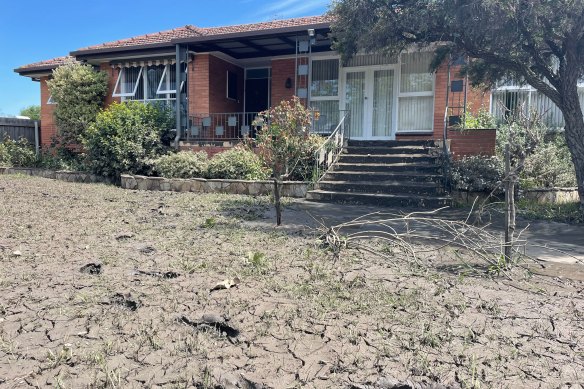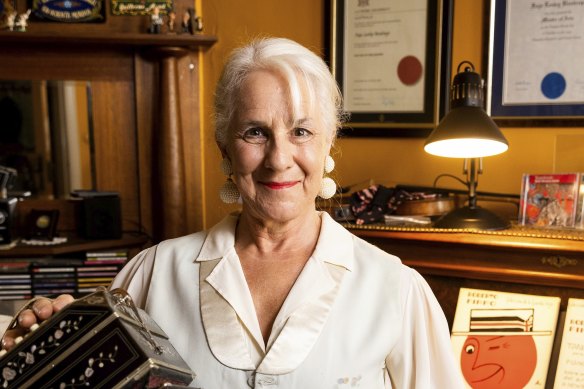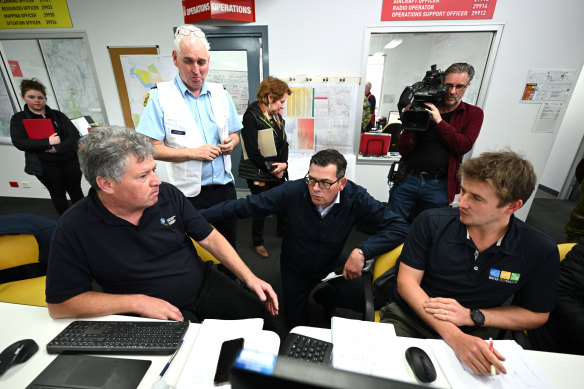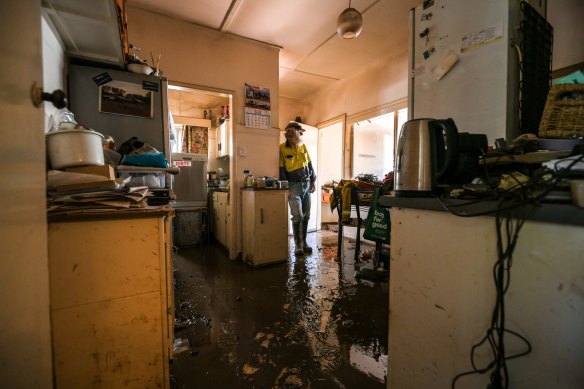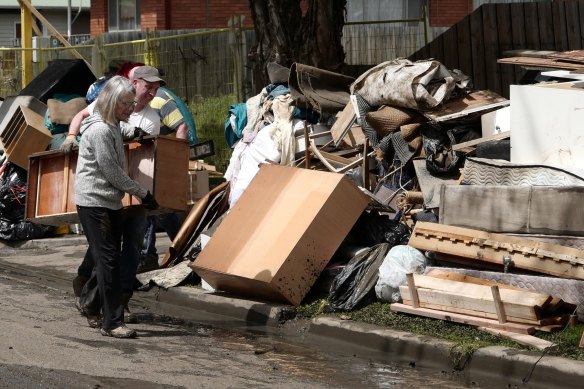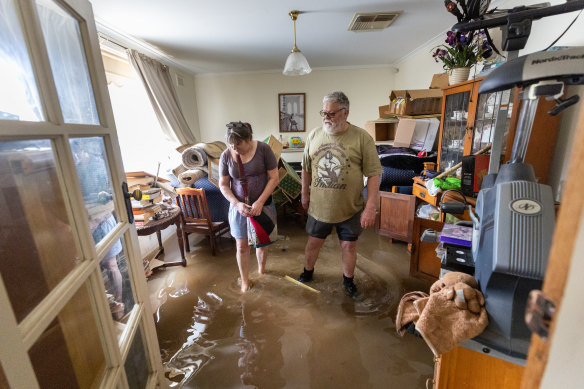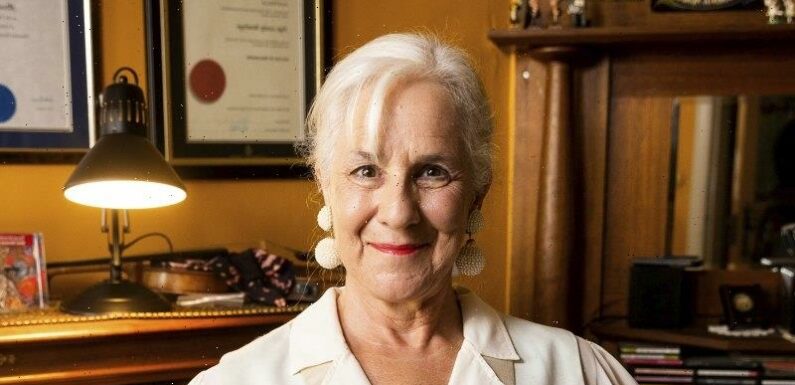
A senior State Emergency Service volunteer says residents near the Maribyrnong River were not given accurate information about the scale of the unfolding flooding disaster, adding her voice to criticisms that evacuation warnings came too late.
Dr Faye Bendrups, deputy controller of partnerships and community engagement at the Footscray SES unit, said there had been a “complete shemozzle of communication” over the past week and vulnerable communities where homes were flooded were left in the dark for too long.
A home on Chifley Drive in Maribyrnong on Monday. Credit:Sophie Aubrey
Her remarks came as Premier Daniel Andrews on Tuesday announced free kindergarten would be available for flood-affected families during term four, with $2 million in grants for sessional kindergartens that have been damaged or have staff and families affected.
VCE students whose homes or schools have been flooded will have their exam results boosted, if necessary, to ensure their marks don’t fall as a result of the disaster, while the government has approved a $5.5 million food relief package to help distribute food to flood-affected areas.
More than 140 schools, early learning centres and TAFEs have been closed as Victoria battles the floods crisis.
“This is far from over – we are going to see more rain, we’ve still got many thousands of people in their homes whose homes are full of water,” Andrews said. “This is a very, very challenging time. There are still warnings that are in place.”
On Friday morning, more than 240 homes in Maribyrnong were inundated.
While residents in the north of the state were preparing their homes against flooding with sandbags, communities in the inner north-western suburb were only awoken by SES volunteers in the early hours of Friday, warning them about the rising level of the Maribyrnong River.
By then it was too late to move furniture and belongings.
Bendrups is an Order of Australia Medal recipient who has been an SES volunteer for 17 years and is president of the Victoria SES Volunteers Association and vice-chair of the National SES Volunteers Association. She said she had decided to speak out publicly after what she witnessed on the ground last week.
Faye Bendrups has been an SES volunteer for 17 years.Credit:Paul Jeffers
“The people of Maribyrnong were given no accurate information about the scale of the flood, the notifications were given to a very limited number of residents and only later expanded to many others,” Bendrups said.
“Few knew there was a relief centre or where it was, few had any idea about what to do and what to take or how long it might last.”
Geoff Crapper, a former Melbourne Water hydrologist, who was responsible for Melbourne’s flood warning service from 1989 to 2003, said the warning issued to communities near the Maribyrnong River on Friday morning was between six and nine hours late.
He said publicly available flood data for the Maribyrnong river system – showing water levels peaking upstream at Darraweit above seven metres last Thursday – should have “set off alarm bells” at Melbourne Water to issue a major flood warning for Melbourne.
“You know when it gets to certain levels at Darraweit that the Maribyrnong is going to have a significant flood,” he said.
Crapper said river levels above five metres at Bulla on Thursday evening should also have been another red flag for authorities.
When questioned on Tuesday about the modelling, state Emergency Management Commissioner Andrew Crisp said Melbourne Water was responsible for providing the data that is used to issue warnings, in consultation with the Bureau of Meteorology.
Ron Sutherland, who was a manager at Melbourne Water for two decades, said there should have been a six-hour warning for houses on the Maribyrnong.
Premier Daniel Andrews visits the Shepparton incident control centre.Credit:AAP
“What they had was police knocking at their door saying there’s water at your gate, evacuate,” he said. “It’s not good enough.”
Authorities previously said the water surged much faster than modelling had predicted. SES incident controller John Bates last week said modelling was “complicated”, involving predicting rainfall, catchment mapping and tides.
“They knew something was coming, but … the scale of it was more certainly than I was aware of,” Bates said. “It just came up really fast. And surprisingly fast to all of us.”
Less than a fortnight ago, Bendrups emailed local politicians and community groups to warn them of the “precarious situation” at the Footscray SES unit, which services the local government areas of Maribyrnong and Melbourne.
Flooding devastated the town of Rochester in central Victoria.Credit:Justin McManus
She said the unit was operating out of a “not fit for purpose” facility in a corner of the Maribyrnong Council Operation Centre’s warehouse. She also said the SES had removed Footscray’s only remaining rescue truck to deploy to another unit after the agency removed most of its heavy vehicle fleet from service across the state due to cracking issues.
The Footscray unit had also been left with just one inflatable rescue boat after one was given to another division, leaving it with just two utes and a boat.
Bendrups said at 8am on Friday, before her shift started, she went to the police check point near the Maribyrnong River and told the local officer more streets were expected to be flooded.
“The police officer said she would tell ‘them’. I don’t know who ‘them’ was,” Bendrups said. “But nothing happened. Two hours later, the houses were flooded. Those residents could have been given enough warning to at least move their belongings or their cars, but they weren’t.”
Residents near the Maribyrnong River move their flood-damaged belongings. Credit:Luis Ascui
She said under normal circumstances during emergencies in Melbourne’s north-west, the SES activates its headquarters in Sunshine to operate as an incident control centre. She said it was not activated late last week and the disaster was instead managed from the relief centre, which does not have the same equipment or communications resources.
Asked about Bendrups’ criticisms, an SES spokesman said it issued a number of public information products and warnings to the Maribyrnong community, which began with a doorknock on Tuesday.
“A Watch and Act was issued on Thursday, followed by the emergency alerts and door knocks to evacuate early on Friday morning,” the spokesman said.
Meanwhile, the Bureau of Meteorology’s Michael Efron on Tuesday said while floodwater was receding slowly across Victoria, showers and thunderstorms would develop again from Wednesday, particularly over northern parts of the state.
The rainfall is not expected to be as heavy or widespread as last week, but there could be localised falls of up to 50 millimetres.
Residents in Shepparton and the nearby towns of Mooroopna, Orrvale, Murchison and Kialla West have been told it is too late to leave. In the state’s north-west, Kerang residents are preparing for rising floodwater that could isolate the town for a week, while an emergency warning asking people to move to higher ground remains in place between the town and the Loddon Weir on the Loddon River.
On the Campaspe River between Echuca and Bendigo in Victoria’s north, the flood-hit town of Rochester is also still under an emergency warning asking people to move to higher ground. Downstream along the Campaspe, Echuca is also under an emergency warning.
The small town of Barmah on the Murray River was on Tuesday afternoon told to evacuate immediately because major flooding that exceeds or is similar to the 1993 floods is likely to occur.
About 380 roads remain closed across the state, Andrews has said, while 200 have re-opened. Overall, there have been more than 14,700 applications for emergency payments and 55 sandbag collection points set up.
Sarah Sweeney, who lives in Abernethy Street in Shepparton, said everyone was pitching in to help and sandbagging had helped stave off the water in most people’s homes.
“The ones who have been here through the floodwaters, it’s actually been a real community. Everyone has been out, helping each other and checking on each other,” she said. “I think the anxiety levels have gone up a bit today with everybody being able to come back in.”
The small riverside town of Mooroopna is usually accessed from Shepparton by a four-kilometre long causeway, raised above the river flats and dotted with red gums.
The road has been closed by the flooding since Saturday, but on Tuesday afternoon it opened to emergency vehicles and walkers, with a steady procession of people on foot, bikes and horses crossing to see how the shut-off community had fared.
Only the pub and the bottle shop were open, as army trucks and emergency service vehicles rattled through the main street.
Some streets in Mooroopna had seen significant flooding, with houses still covered in water above the window sills.
The causeway itself had “bubbled” in sections, with the road swelling over the water underneath, and there was an audible sound of rushing water under the asphalt
On the sides of the causeway were a couple of dozen kangaroos, both alive and dead.
Mooroopna locals Shelly Perry and Bill Weston return to their home for the first time since it was inundated. Credit:Jason South
The live ones stood, blinking, in the grass, forced on to the solid ground of the verges as the swollen Goulburn River rushed past.
The dead lay with pink crosses on their chest, an unhappy collateral of collisions with evacuating vehicles, as animals and humans were forced to share what dry land remained.
In the oldest part of the small town, low-lying homes were still inundated with brown floodwater yesterday and largely empty of residents.
Shelly Perry and Bill Weston had evacuated to nearby Ardmona during the heavy rains, but returned to their 100-year-old cottage on Tuesday afternoon to find 20 centimetres of water still sloshing across their floors.
“We were really wanting to get back because not knowing what had happened was awful,” Perry said.
“In this case, reality was better than our imagination”.
The pair had lifted the fridge up on a motorcycle jack, put their couches on tables and knotted up the curtains so they couldn’t wick up the floodwater.
They are worried about the rain still predicted to come, but feel lucky compared with some.
“We have somewhere dry to stay and we’re healthy.”
With Miki Perkins
The Morning Edition newsletter is our guide to the day’s most important and interesting stories, analysis and insights. Sign up here.
Most Viewed in Politics
From our partners
Source: Read Full Article
